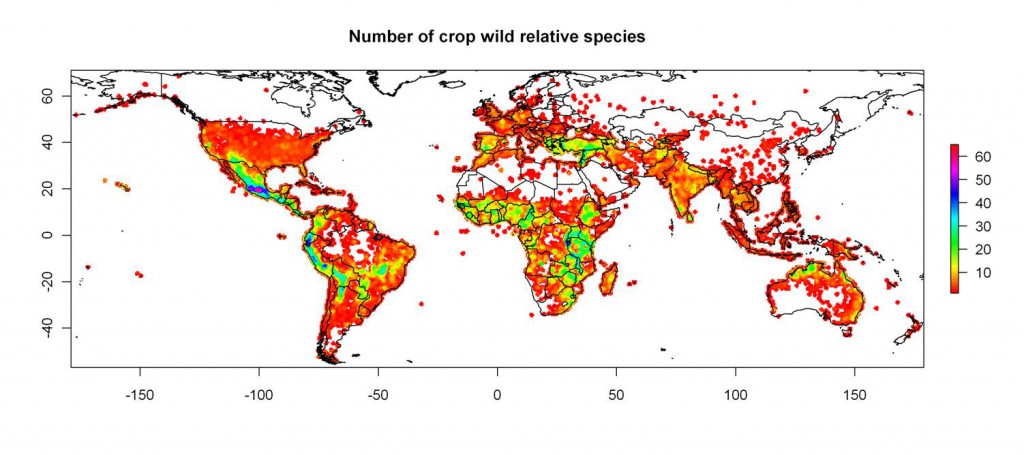- A view from Papua New Guinea on a project to prepare PNG agriculture for climate change.
- How to grow a properly biodiverse pasture. Hint: money isn’t enough.
- Another Nagoya round-up. And another.
- Sesamum monographed.
- Award for CIMMYT genebank.
- African rice domestication deconstructed.
- Traditional practices bad for Nigerian children, good for Chinese fish.
Jebel Abdul Aziz protected area to get development help
Maybe it’s the spirit of Nagoya, but the Global Arab Network is announcing that
the State Ministry for Environment Affairs, the Ministry of Agriculture, the United Nations Development Program and the local committees of the villages of Abdulaziz Mountain reserve signed on Tuesday three agreements for establishing development projects…
The aim?
…serving national communities in Abdulaziz Mountain area and reducing the effect of human activity on biodiversity in it, in addition to supporting the joint administration of the reserve’s resources among the various relevant establishments and organizing the management of the grants provided to local committees.
The Jabal Abdul Aziz protected area is in northeastern Syria, where the vegetation “represent[s] the nearest living examples to Neolithic sites along the Euphrates.”
The area clearly has eco-tourism potential. It’s also got crop wild relatives and other plant genetic resources:
The site includes a number of species that have an economical and ecological importance. Of these we mention:
(1) Genetic resources of fruit trees, Of these are: Pistacia atlantica, Pistacia khunjuk, and Amygdalus orientalis
(2) Excellent protein rich forage species. Of these we may mention Atriplex leucloda, Avena barbata, Dactylis glomerata, Salsola villosa, Stipa barbata, Aegilops spp., and Vicia spp.
(3) Medicinal plants are present in prosperous populations. Some of these species are: Thymus syriacus, Artemisia herba-alba, Capparis spinosa, Teucrium polinum, Achillea spp., Ziziphora spp.
(4) Ornamental species adapted to dry zone such as Gladiolus aleppicus, Ixiolirion tataricum and Tulipa montana are found too.
But will it be managed in such a way as to maintain these species?
Did wild relatives get a boost at Nagoya?
I think I may have Nibbled the fact that IUCN released a few days ago at Nagoya the results of a massive study of the global pattern of threat to vertebrate diversity. Here’s the money map:
Also to coincide with Nagoya, IUCN collaborated with Kew and the Natural History Museum, London on a global analysis of extinction risk for the world’s plants.
And of course, the A-Z Guide of Areas of Biodiversity Importance was launched at a side event at COP 10. The press release is on the UNEP website.
Compare and contrast with this map Julian Ramirez of CIAT has kindly sent me, showing the richness of wild relatives of a dozen or more major crops. Question for anyone who was at Nagoya: were livestock and crop wild relatives discussed during the proceedings?
I ask because in a recent posting on the Crop Wild Relatives discussion group, Nigel Maxted suggests that launching an initiative to “(establish) … a Global Network of CWR Protected Areas is now a real priority, along with systematic ex situ conservation!”
So what happened?
Nibbles: CBD COP, Biofortification, Foodie potatoes, Dates date, Reintroductions, Quercus, Nomenclature, Maize, P, Agroforestry, Weeds, VIR, Lactose intolerance, Yersinia
- Bioversity DG “jubilant” at Nagoya Protocol.
- A video plug for the biofortification conference.
- Native potatoes on foodie agenda.
- A date palm festival. In the US.
- The success of species introductions.
- Italian acorn cakes deconstructed. I’m told the people able to recognize these sweet acorns are few and old.
- Calling times on biological names. Whoa!
- Saving heirloom mielies.
- What the heck is happening with phosphorus anyway?
- Panamanian farmers don’t like to grow (some) native trees on their farms because of slow growth rates.
- Eating medieval weeds.
- Latest from Pavlovsk. I have no idea what’s going on anymore.
- Lactase persistence due to cold.
- Genetics says plague came from China.
Nibbles: African data, Wild beans, Wild chickens, Heirloom tomatoes, Wild wheat
- African data centre planned.
- “…genetic variability and phenotypic plasticity of plant anti-herbivore defences allow plant populations to rapidly respond to changing environmental conditions.” In a crop wild relative, no less.
- The genetics of chicken domestication. I’d like to see the results of those crosses.
- Do you have these heirloom tomatoes?
- Getting increased heat tolerance from a wild relative into wheat.

